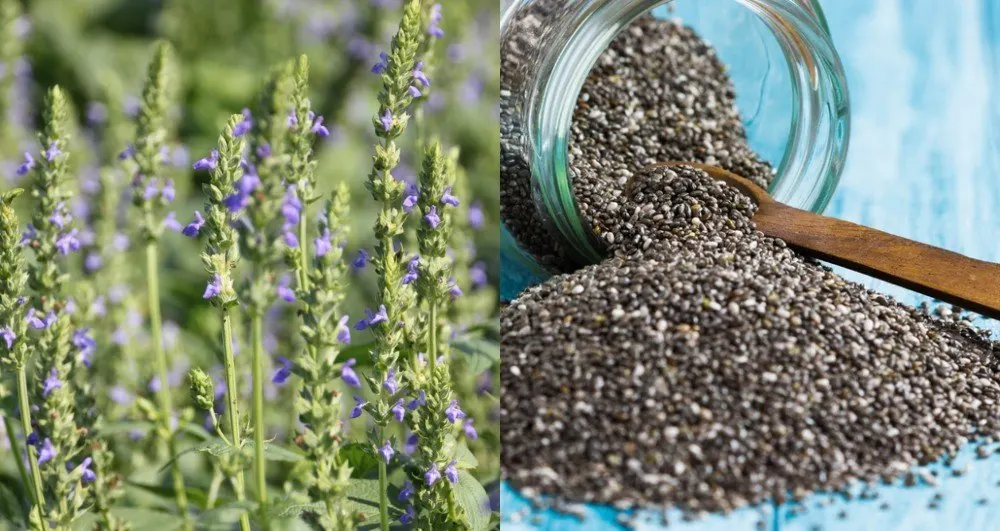Chia seeds are a superfood rich in omega-3 fatty acids and other essential nutrients. You can even grow and harvest your own chia seeds at home. Expert Sarah Jay shares her tips on how to do it.
Chia seeds are a superfood packed with omega-3 fatty acids. People buy them to add protein to meals or as an egg substitute in vegan diets. Chia sprouts are also popular in the kitchen. Luckily, chia seeds come from the chia plant, which is easy to care for once established!
Even if you don’t eat chia seeds, growing chia plants brings health benefits to your garden. Their flowers are beautiful, and they thrive in various conditions. They have almost no pests or diseases and a long growing season, so you can enjoy their leaves and flowers longer than expected.
Chia is an easy addition to gardens in the Southeastern U.S., Central America, and South America. It also grows well in greenhouses in colder climates and can even be grown as a small indoor tree.
If you want to grow chia for its health benefits, you might save yourself a trip to the health food store. Let’s talk about how to grow chia!
Overview
| Plant Type | Annual herb, pseudocereal |
| Family | Lamiaceae |
| Genus | Salvia |
| Species | Salvia hispanica |
| Native Area | Guatemala and Mexico |
| Exposure | Full sun |
| Height | 5-9″ |
| Watering Requirements | Low |
| Pests & Diseases | Root rot |
| Maintenance | Low |
| Soil Type | Well-draining, average |
| Hardiness Zone | 8-11 |
What is Chia?
There are two main chia species grown at home: Salvia hispanica (Mexican chia, Mexican sage, Spanish sage) and Salvia columbariae (golden chia, desert chia). Both belong to the mint family (Lamiaceae), which includes mint, deadnettle, and sage. Chia is grown for its seeds, used in baked goods, overnight oats, and drinks. The leaves are also edible, best when young—older leaves turn slightly bitter.
Native Area

They are edible with medicinal properties.
Chia is native to Central Mexico and Guatemala. Indigenous peoples in these regions and the Southeastern U.S. used it as food and medicine long before colonization. The Nahuatl, Maya, Inca, and Aztec peoples developed today’s chia cultivars. The word chian means “strength” in Mayan cosmology and “oily” in Nahuatl.
Characteristics

They tend to grow tall and narrow.
Chia grows annually, reaching up to 6 feet tall and spreading 18 inches wide. Its 1-2 inch leaves grow opposite each other on square stems, covered in tiny hairs. In late spring to early summer, blue flowers bloom, attracting bees, butterflies, and hummingbirds.
The flowers self-pollinate. After blooming, seed heads dry, producing tiny white and brown seeds. Like other mint-family plants, chia has shallow roots and self-sows, returning yearly.
Uses

The seeds have significant nutritional value.
Chia seeds are rich in omega-3s and support healthy blood sugar, bone density, and weight loss. They also help lower heart disease risk and stabilize blood pressure. Chia sprouts gained fame through chia pets—clay figures where seeds sprout into fun shapes, like Bob Ross’s hair.
Varieties
Salvia hispanica has flower spikes, while columbariae has clustered, bee balm-like flowers. Hispanica seeds are black and brown (common in stores), while golden chia seeds are tan and gray.
Hispanica thrives in humid climates, while columbariae prefers dry deserts. Both have similar nutritional benefits and uses, like chia pudding.
Planting

They are easy to grow using the seeds.
Growing chia is easy if you start with seeds. Plant them in fall, indoors or outdoors. For best germination, hydrate seeds until they form a gel-like coating, then spread them on soil with a popsicle stick. Keep soil moist—seeds sprout in a couple of weeks.
For indoor starts, transplant seedlings at 3 inches tall. Space plants 6 inches apart in well-draining soil with full sun.
How to Grow
Now that you’ve planted chia, here’s how to care for it.
Light
Chia loves 6-8 hours of direct sun daily. Too much sun burns leaves; too little makes plants weak and spindly.
Water
Water regularly in the morning, especially in warm seasons. Once established, chia is drought-tolerant. Use drip irrigation or soaker hoses. Avoid overwatering after heavy rain to prevent root rot.
Soil
Chia grows best in well-draining soil, from average to clayey. If soil is compacted, mix in sand or potting soil for better drainage. Ideal pH is 6.5-8.5.
Fertilizing
Chia doesn’t need much fertilizer. Add compost or well-rotted manure at planting. A diluted foliar feed once or twice during growth is enough.
Temperature
Chia thrives in USDA zones 8-11, preferring 61°F-79°F. It tolerates temps down to 51°F and up to 96°F but dies in freezing weather. In extreme heat, use shade cloth.
Maintenance
To prevent self-sowing, deadhead flowers. Harvest young leaves for salads or prune sprouts. No other pruning is needed.
Propagation
Chia only propagates via seeds. Let seed heads self-sow or collect and replant them.
Harvesting
Harvest seeds after flowers fade. Cut seed heads when dry, shake them, and listen for seeds. Dry heads on a rack or in paper bags, then crush to extract seeds.
Storage
Store seeds in airtight containers (like mason jars) in a cool, dark place for up to 5 years. Refrigerate or freeze for longer shelf life.
Common Problems
Chia has few pests or diseases, but some growing issues may arise.
Growing Problems

Under unfavorable conditions, it might not grow properly.
Chia is drought-tolerant but may scorch in extreme heat. Provide extra water during heatwaves. Poor drainage can also cause issues.
Diseases

They are prone to root rot.
Root rot occurs in poorly drained soil. Transplant affected plants to fresh, sandy soil. If the plant dies, solarize the soil and replant next season.

